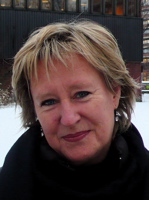- Those who thought that the family would not survive the changes that have occurred over the last forty years have been wrong in many ways, says Professor Anne Lise Ellingsæter. She and Professor Karin Widerberg are the editors of the new book Velferdsstatens familier – Nye sosiologiske perspektiver (Families of the Welfare State - New sociological perspectives).
What kinds of families are formed in a welfare state like Norway? And how have families changed the welfare state? What is a family? Who provides for the family? Do different family forms lead to the dissolution of the family? These are some of the questions a group of sociologists take up in the new book.
- There have been dramatic changes in recent years. Not only in government schemes and regulations, but in how people live in families. The aim of the new book is to present current research and describe these changes - both changes that can be measured statistically such as jobs, wages, etc., and changes in understanding of what has happened, says Widerberg.
Economic Rights
Ellingsæter says that one of the main ambitions of this book is to clarify the long line of historical changes in the family.
- Several of the articles have an historical perspective. One example is Jorun Solheim’s chapter. She emphasizes the particular form of family that has characterized North West Europe from pre-modern times, where a woman's right to inherit from her spouse was central. It is an often overlooked dimension that underlies the patterns we see today.
Solheim shows that the northwestern European form of family, the nuclear family, where spouses are key, is peculiar to this part of the world. Elsewhere, the extended family often organizes the family mold. Northwestern European women have basic legal rights concerning the family’s economic resources and property. This was uncommon in most other cultures, according Solheim. The family's resources have been ruled to be common between spouses. In this way, women have had a type of financial security both within marriage, and if they were widowed or divorced. This family legal principle is now beginning to change in favour of more individualized rights, writes Solheim.

Children of divorces who divorce
- The second aim of this book is to dig a little deeper into what's happening now. We try to find new concepts for what we see, and go behind some of the prevailing understandings of how things are. For example, in the chapters that deal with immigration and families, and in Karin’s chapter on divorce, says Ellingsæter.
Widerberg interjects:
- Yes, this is the first time in our part of the world where many of the young people who are entering into a divorce process have experienced divorce as children. We wonder whether those who have those who have experienced their parents’ divorce will divorce differently than those who have not. It is a completely new phenomenon. What are the consequences? How do they conduct their divorces? And how do they do “family”?
There is a growing trend of shared custody of the children after divorce, writes Widerberg and Tone Kummen in their chapter. We also find that it is more common for fathers to maintain an active role after divorce. In addition they have found that shared custody is more common among people with higher education and active employment than others. What kind of scheme a family chooses for divorce is thus related to class, write Widerberg and Kummen.
The family remains
- Although the book shows many of the changes that have occurred in the family, many of the chapters focus on what has remained stable. Can you say something about that?
- People continue to establish relationships, and family-like forms. But they do it in a different way, says Widerberg.
- There are several family forms which now have official blessing. We see this clearly in Turid Noack and Lyngstad Torkild’s chapter on relationship changes over the last fifty years, under the title of Samlivsrevolusjonen (the cohabitation revolution). The biggest change they find is the rise of cohabitation. Another important change is that there are more breakups than before. They emphasize that there are now more legal and acceptable options for the family to choose from.
- Some researchers believe that the growth in the number of acceptable family forms is a source of instability. Opponents to these policy changes have viewed this as the breakdown of the family. But I think this is wrong. I believe that in the long term this can be a stabilizing factor. The fact that you have a greater degree of equality and recognition of different types of families can be a source of stability, claims Ellingsæter and continues:
- As an example, there is the new marriage law that includes lesbians and gays. These groups embrace the traditional family institution. They have campaigned for the right to be as similar as possible to the majority. It says something about the value of the family. Family and children are attributed immense importance in Norwegian society.
The economy reigns
How is the welfare state is important for family change?
- The welfare state creates an economic basis for the nuclear family household. I have just been visiting scholar at the European University Institute in Florence, and there a Spanish researcher told me that a tendency in Spain now, during the economic crisis, is that people are living in extended family units. People move together to share resources and expenditure, says Ellingsæter.
 Professor Karin Widerberg (photo: UiO)
Professor Karin Widerberg (photo: UiO)The editors emphasize that the sociology of the family has often been studied as a stage for the expression of emotions and culture, but less in terms of economics and law. Therefore, it was important that several of the chapters in the book look at the economic state of the family. For example, Kari Skrede and Kenneth Aarskaug Wiik’s chapter that if the woman in the family earns as much or more than the man, they share the tasks in the home more equally. If the man has a high income, they tend toward more traditional patterns.
- It shows how extremely important it is to equalize income between men and women. There is an underlying economic rationality, says Ellingsæter.
In addition, Ellingsæter shows in her chapter that financial equality is related to family policies.
- It has been common to argue that family policies help to maintain class distinctions, but I think that family policy has contributed to reducing disparities in the region. Women of all social classes are in paid work. This is peculiar to the Nordic model.
- An important difference between the Nordic countries and countries in southern Europe is that women of all social classes are employed. In all countries, women with higher education take part in the labour market regardless of family policy. But in the Nordic countries, the majority of mothers with lower education are also in work, explains Ellingsæter.
- Here I think that universal kindergarten availability is also important. It's not that expensive to have a child in kindergarten in Norway, and it has spread to all social classes. 97 percent of all children between three and five years and 90 percent of children between one and five years are in kindergarten.
Kindergarten places came later
- Claiming of the cash-for-care benefit for pre-school not at kindergarten has decreased from 75 percent to 25 percent in ten years. What is interesting is that we've only seen a small increase in maternal employment in the same period. Mothers have worked anyway. But previously there was an extreme shortfall of kindergarten places, says Ellingsæter. She goes on enthusiastically:
- Mothers have gone out to work and kindergarten places have slowly followed. There has been a problem for forty years. When the Kindergarten Act was implemented in 1975, it was agreed that those who wanted their children in daycare could do so. And then it took almost forty years before we got universal places. Arnlaug Leira wrote about this in 1992, and she also has a chapter in this book. It was not the welfare system that pushed women into the workforce. There were women who wanted to work, and they demanded welfare programmes that accommodated this.
- It shows that it is important to consider that families are active in creating change. It's not that the family is always exposed to outside forces and then adjusts to them. Families create change, Ellingsæter affirms.
The article was written by Anita Haslie and previously published in Norwegian at KILDEN. English translation by Matthew Rix Whiting
